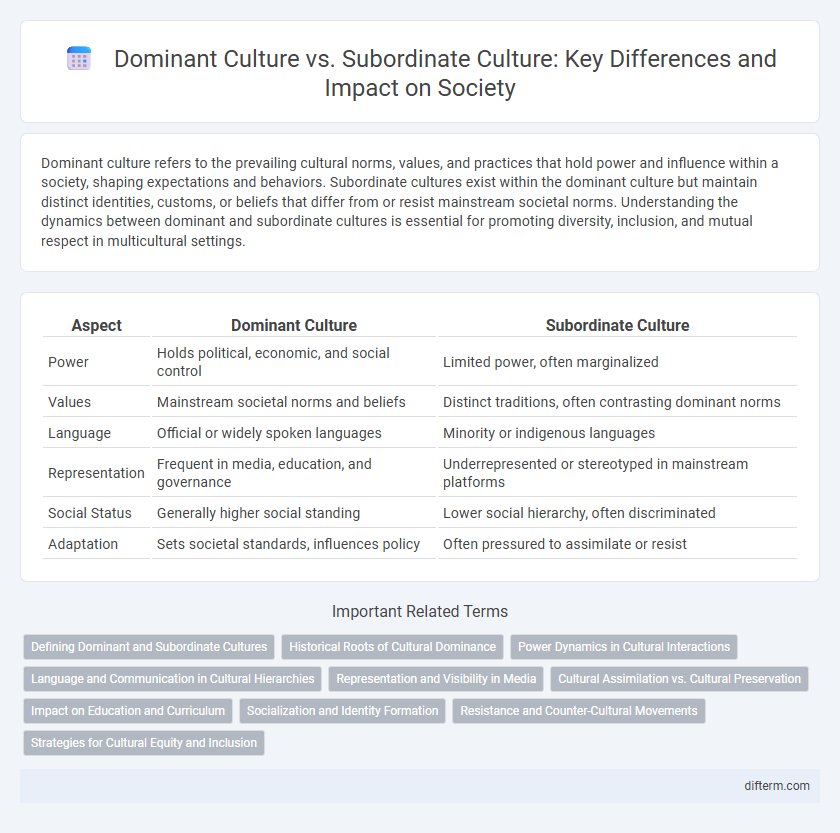Dominant culture refers to the prevailing cultural norms, values, and practices that hold power and influence within a society, shaping expectations and behaviors. Subordinate cultures exist within the dominant culture but maintain distinct identities, customs, or beliefs that differ from or resist mainstream societal norms. Understanding the dynamics between dominant and subordinate cultures is essential for promoting diversity, inclusion, and mutual respect in multicultural settings.
Table of Comparison
| Aspect | Dominant Culture | Subordinate Culture |
|---|---|---|
| Power | Holds political, economic, and social control | Limited power, often marginalized |
| Values | Mainstream societal norms and beliefs | Distinct traditions, often contrasting dominant norms |
| Language | Official or widely spoken languages | Minority or indigenous languages |
| Representation | Frequent in media, education, and governance | Underrepresented or stereotyped in mainstream platforms |
| Social Status | Generally higher social standing | Lower social hierarchy, often discriminated |
| Adaptation | Sets societal standards, influences policy | Often pressured to assimilate or resist |
Defining Dominant and Subordinate Cultures
Dominant culture refers to the cultural practices, values, and norms upheld by the majority or those in power within a society, shaping social institutions and public policies. Subordinate culture consists of groups whose cultural expressions and identities differ from or challenge the dominant norms, often facing marginalization or limited access to resources. Understanding the dynamics between dominant and subordinate cultures is essential for analyzing social power structures and cultural integration.
Historical Roots of Cultural Dominance
Historical roots of cultural dominance often stem from colonialism, imperialism, and the spread of powerful empires that imposed their language, customs, and values on subordinate cultures. These dominant cultures establish social hierarchies through institutionalized practices and control over resources, influencing subordinate groups' identities and everyday lives. Resistance and adaptation by subordinate cultures reveal the dynamic and contested nature of cultural dominance throughout history.
Power Dynamics in Cultural Interactions
Power dynamics in cultural interactions often manifest through dominant cultures imposing values, norms, and practices on subordinate cultures, leading to unequal access to resources and influence. Dominant cultures shape societal structures, media representation, and institutional policies, reinforcing their authority and marginalizing subordinate cultures. This imbalance perpetuates cultural hegemony, limiting the subordinate culture's capacity for self-expression and autonomy within the broader social context.
Language and Communication in Cultural Hierarchies
Dominant cultures often impose their language and communication styles as the societal norm, shaping educational systems, media, and official discourse, which marginalizes subordinate cultures' linguistic expressions. Subordinate cultures face challenges preserving their native languages and communication methods, leading to language attrition and reduced cultural visibility. This linguistic hierarchy perpetuates power imbalances, affecting identity, social inclusion, and access to resources within multicultural societies.
Representation and Visibility in Media
Dominant cultures are often overrepresented in mainstream media, shaping societal norms and influencing public perception through extensive visibility. Subordinate cultures frequently experience underrepresentation or stereotypical portrayals, which limits authentic visibility and reinforces cultural hierarchies. Media representation directly impacts social inclusion, identity affirmation, and the equitable visibility of diverse cultural narratives.
Cultural Assimilation vs. Cultural Preservation
Cultural assimilation involves the dominant culture influencing subordinate cultures to adopt its values, norms, and behaviors, often leading to the erosion of minority cultural identities. In contrast, cultural preservation emphasizes maintaining and protecting the unique traditions, languages, and practices of subordinate cultures despite pressures from dominant cultural forces. The dynamic tension between these processes shapes social integration, identity politics, and multicultural policy development worldwide.
Impact on Education and Curriculum
Dominant culture shapes educational standards and curriculum by prioritizing its own values, history, and language, often marginalizing subordinate cultures. This leads to a lack of representation for minority perspectives, impacting student identity and engagement. Incorporating multicultural content can enhance inclusivity, equity, and cultural competence in learning environments.
Socialization and Identity Formation
Dominant culture shapes socialization processes by promoting norms and values that influence individual behavior and group identity formation within a society. Subordinate cultures often navigate identity formation through resistance and adaptation to the dominant cultural narratives, fostering unique expressions of selfhood and community cohesion. Socialization in subordinate cultures involves transmitting alternative beliefs and practices that challenge or complement the prevailing cultural framework, reinforcing diversity within social structures.
Resistance and Counter-Cultural Movements
Resistance within dominant culture often sparks the rise of counter-cultural movements that challenge mainstream values and norms. Subordinate cultures actively preserve unique identities and practices while opposing assimilation pressures through art, music, and grassroots activism. These movements promote social change by highlighting inequalities embedded in dominant cultural narratives and advocating for marginalized voices.
Strategies for Cultural Equity and Inclusion
Dominant cultures often shape societal norms and institutional policies, creating challenges for subordinate cultures in achieving equitable representation. Strategies for cultural equity and inclusion include implementing inclusive curricula, promoting diverse leadership, and fostering intercultural dialogue to dismantle systemic biases. Emphasizing equity ensures that subordinate cultures have equal access to resources, participation, and recognition within various social and organizational contexts.
dominant culture vs subordinate culture Infographic

 difterm.com
difterm.com